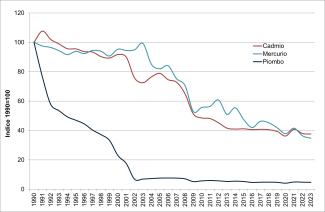Panel 1
Daniela Romano
The indicator represents the time series of national emissions of heavy metals from 1990 to 2023, by source sector. Since 1990, a reduction in emissions has been observed for all metals. In particular, emissions of cadmium, mercury and lead are in line with the objectives set at the international level by the Aarhus Protocol, having decreased compared to 1990 values by -62%, -65% and -95%, respectively.
Emissions of heavy metals mainly derive from combustion, both industrial and non-industrial, from production processes and from the energy sector. Heavy metals are of considerable health relevance as they persist in the environment, giving rise to bioaccumulation phenomena, and are also recognized as important carcinogenic agents. Among these, cadmium (Cd) falls into class 1 (proven carcinogens) of the International Agency for Research on Cancer.
The purpose is to estimate the total national emissions of heavy metals, and their disaggregation by productive activity sector, that makes it possible to evaluate the emission trend in the period under consideration and compare it with the objective established by the Aarhus Protocol.
The Aarhus Protocol on Heavy Metals (1998), within the framework of the Geneva Convention on Long-Range Transboundary Air Pollution (1979), sets as a reduction objective for cadmium (Cd), mercury (Hg) and lead (Pb) the emission values of 1990 (or, alternatively, any other year between 1985 and 1995).
Panel 2
ISPRA, 2025. Italian Emission Inventory 1990-2023. Information Inventory Report 2025
Data quality assessment
Used ISPRA data from the National Inventory of Atmospheric Emissions (http://emissioni. sina. isprambiente. it/interno-nazionale/).
National
1990-2023
Indicator assessment
Estimate carried out for the purpose of drafting the national atmospheric emission inventory. For atmospheric pollutants, the methodology used is that indicated by the European Environment Agency (EMEP/EEA Guidebook – 2019). For a detailed description of the estimation methodology, reference is made to the Informative Inventory Report – IIR (https://www.isprambiente.gov.it/it/pubblicazioni/rapporti; https://www.ceip.at/status-of-reporting-and-review-results/2025-submission).
Emissions of cadmium, mercury and lead are in line with the objectives set at the international level, having decreased in 2023 compared to 1990 by 62%, 65% and 95%, respectively. Objectives were already achieved in 1993 for cadmium and in 1991 for mercury and lead (Table 1, Figure 1).
Decreasing trends are observed for the emissions of all three heavy metals (Table 1 and Figure 1), thus outlining a positive trend from an environmental point of view.
Data
Table 1: National emissions of heavy metals by sector
ISPRA
A: Combustion – energy and transformation industry; B: Non-industrial combustion; C: Industrial combustion; D: Production processes; E: Extraction and distribution of fossil fuels/geothermal energy; F: Solvent use; G: Road transport; H: Other mobile sources; I: Waste treatment and disposal; L: Agriculture.
Emission values have been updated consistently with the annual update of the national emission inventory.

Cadmium shows a decrease throughout the entire period 1990–2023 (-62%), mainly due to the reduction in industrial combustion emissions (-79%), which in 2023 account for 28% of the total (Table 1, Figure 1). The overall reduction in mercury emissions (-65%) mainly derives from industrial combustion (-72%) and production processes (-49%) (Table 1, Figure 1). The reduction in lead emission levels has been remarkable (-95%), mainly thanks to the use of unleaded petrol; indeed, the road transport sector, which between 1990 and 1999 contributed on average more than 83% of total lead emissions, in the period 2002–2023 saw its share decrease to an average value of about 18%. Lead emissions from industrial combustion, although reduced by 73% since 1990, accounted in 2023 for 35% of total emissions (Table 1, Figure 1).